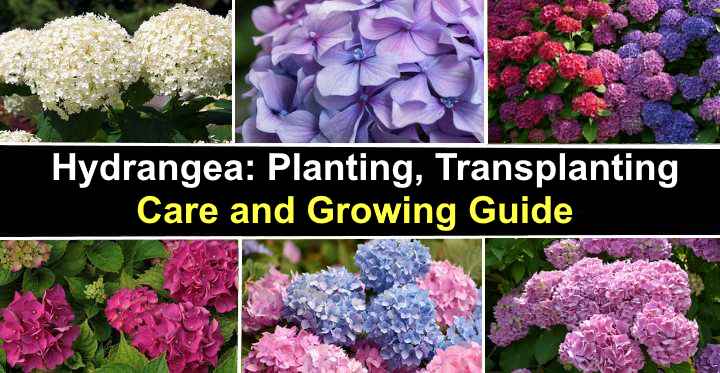In a garden landscape, Hydrangea blooms are among the largest, brightest, and most gorgeous blooms you can produce. From spring through summer and into fall, gorgeous hydrangea bushes provide gardens with magnificent, varied blooms and thick green leaves. The fact that hydrangea blooming shrubs are simple to cultivate in gardens or backyards is one of their charms. Dwarf shrub forms of hydrangea bushes are some of the most stunning patio plants around.
Hydrangea Care Guide
To enjoy hydrangeas flowers, put them in a partly shaded area in your yard. Hydrangeas are perennial plants that bloom throughout the summer as long as the ground has excellent drainage and the soil stays moist. Hydrangeas need little maintenance beyond late summer, late winter, and early spring trimming to bloom on a regular basis.
This is a thorough guide to hydrangea care in a garden environment. Planting, moving, and watering hydrangeas for the greatest outcomes will also be covered in this article.
Hydrangea Bush — General Overview

Hydrangea is a hardy blooming perennial shrub with large domed or flattened flower clusters that adds focus to any landscaped garden. The majority of hydrangea bushes are deciduous shrubs that lose their leaves in the winter. Hydrangea bushes bloom in the spring, summer, and autumn. They grow between 3 and 10 feet (1 and 3 meters) tall.
Hydrangea Flowers: The huge flower heads and broad leaves of hydrangeas have earned them a reputation. Between 4″ and 14″ (10 – 35 cm) across, Hydrangea flowers are known as corymbs.
Hydrangea Leaves: The ovate leaves of Hydrangea have serrated margins and a pointed tip. Hydrangeas have long, wide leaves that may grow up to 6 inches (15 cm) long and 5 inches (15 cm) broad.
Hydrangea shrubs that bloom every year return every year. Knowing when to trim hydrangeas to keep them blooming year after year will be aided in the later section of this article.
Types of Hydrangea Bushes
Hydrangea shrubs come in six different types. The flower or leaf form and growth habit of these hydrangea species are used to categorize them.
Here are the types of hydrangeas:
Bigleaf hydrangea (Hydrangea macrophylla)—Large mophead or pom-pom flowers are the most popular garden hydrangea. Flat flower clusters known as lacecap flowers are also seen in several varieties. The hydrangeas are 4 feet (1.2 meters) tall and broad, and they’re also known as French hydrangea.

Smooth hydrangea (Hydrangea arborescens)—Smooth hydrangeas grow to be 10 feet (3 meters) tall and 6 feet (1.8 meters) broad. Large white globular blossoms on bushy plants look like enormous snowballs.
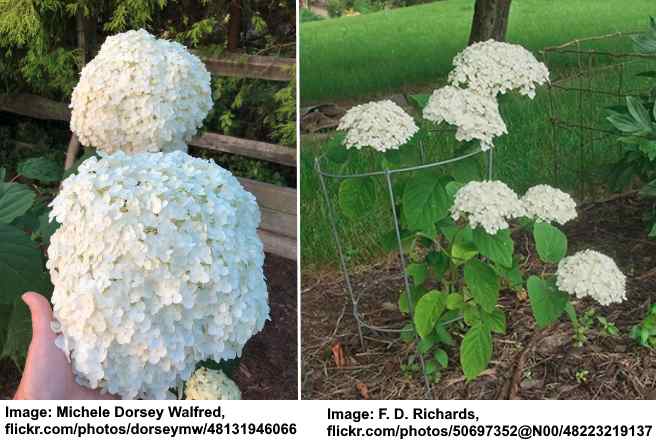
Panicle hydrangea (Hydrangea paniculata)—The cone-shaped flowers of this hydrangea species are well-known. Panicle hydrangeas may reach a height of 3 to 16 feet (1 to 5 meters) and an width of 8 feet (2.5 meters).
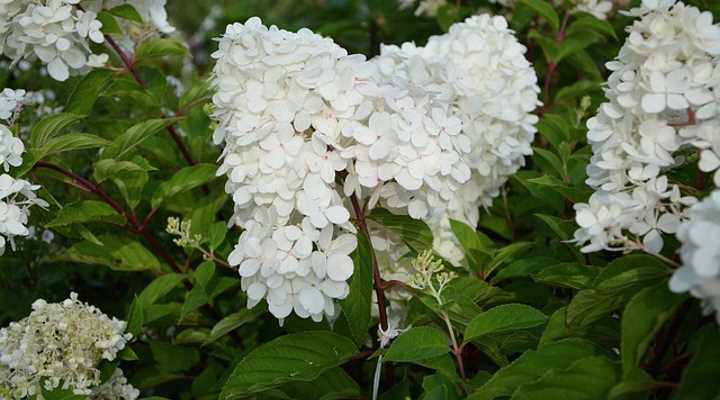
Mountain hydrangea (Hydrangea serrata)—Due to their exquisite lacecap petals and 4 ft. (1.2 m) tall and broad shrubbery, popular hydrangeas are popular.
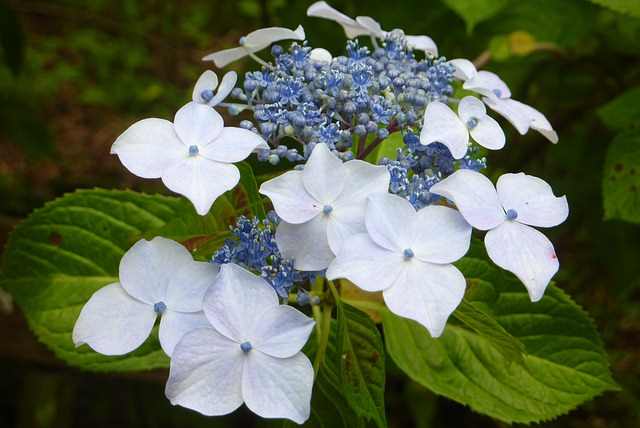
Oakleaf hydrangea (Hydrangea quercifolia)—The foliage of this hydrangea looks like oak tree leaves, hence the name. Oakleaf hydrangeas feature enormous cylindrical blooms that may grow to be 12 inches (30 cm) tall. The hydrangea will grow to be between 3 and 12 feet (1.6 and 3.6 meters) tall.

Climbing hydrangea (Hydrangea petiolaris)—Its long trailing vines help it grow to be the tallest hydrangea, growing up to 50 feet (15 meters) tall. Climbing hydrangeas have flattened flower clusters that can grow up to 10 inches (25 cm) long.

Hydrangea Care: How Much Sun Do Hydrangeas Need?
Hydrangea bushes thrive in partial shade and receive up to six hours of sunlight every day. Plant a hydrangea hedge where it receives morning and afternoon sun, as well as shade from harsh midday heat. Most hydrangeas do well in full sun in colder zones.
Hydrangeas prefer partial shade in hot, humid climates and get two hours of direct sunlight. Hydrangeas, for example, may fade in color and wilt if grown in full sun in Florida. Plant the bushes in the shade to help bigleaf and panicle hydrangeas grow in climates such as Florida.
Hydrangea Growing Zone
Depending on the cultivar, hydrangeas may be found growing from USDA zones 3 through 9. Zone 3 is ideal for some types of smooth and panicle hydrangeas. Most hydrangeas should be hardy enough to grow in zone 4 with additional frost protection.
Bigleaf hydrangeas, the most popular types of hydrangea, are suitable for growing from zone 5 to 9. Make sure the bushy shrubs are shielded from the sun and get enough water throughout hot weather in hotter climes.
How Big do Hydrangeas Get?
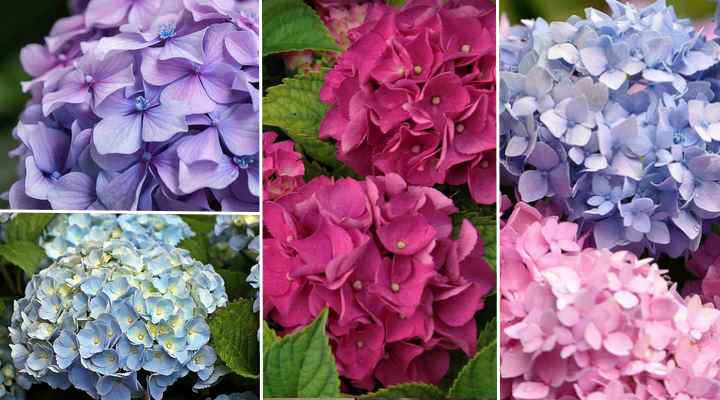
Bigleaf hydrangea grows to be 4 feet (1.2 meters) tall and broad. Landscape hydrangea bushes grow as tall and broad as they can. The largeleaf hydrangea, which grows to 4 feet (3 meters) tall and broad, is a popular species. The following is a list of hydrangeas, with their sizes:
- Bigleaf hydrangea: 4 – 10 ft. (1 – 3 m) high by 4 – 10 ft. (1.2 – 3 m) wide
- Panicle hydrangea: 3 – 16 ft. (1 – 5 m) high by 8 ft. (2.4 m) wide
- Smooth hydrangea: 3 – 12 ft. (1 – 3.6 m) high by 6 ft. (1.8 m) wide
- Oakleaf hydrangea: 12 ft. by 12 ft. (3.6 x 3.6 m)
- Mountain hydrangea: 4 ft. by 4 ft. (1.2 x 1.2 m)
- Climbing hydrangea: 50 ft. (15 m) high by 6 ft. (15 x 1.8 m) wide
Individual hydrangea cultivars, of course, may vary in height and spread. Dwarf hydrangeas are noticeably smaller, for example. The majority of hydrangea species have a rapid development rate. Hydrangeas grow to their full height in about 2 feet (60 cm) each year, depending on the species. The best way to encourage growth is to plant hydrangeas in partial sun and keep the soil damp.
Are Hydrangeas Deer Resistant?
Deer are relatively tolerant of hydrangeas; nonetheless, hydrangeas are not considered deer-proof. The most deer-resistant types are generally oakleaf hydrangeas and climbing hydrangeas. Deer may eat hydrangea leaves if there is nothing more tasty to forage on, despite the fact that they aren’t attracted to bigleaf hydrangeas or the other species.
Planting Hydrangea

Hydrangeas should be planted in the early spring in partial shade, away from the scorching heat of the day. Hydrangea shrubs are some of the most popular flowers for landscaping because of their low maintenance. Yet, planting hydrangeas in the proper location is critical for their success.
Where to plant hydrangeas
Planting a hydrangea in the best location is when it gets some shade from the midday sun. Typically, select a location with rich, organic-matter-rich soil and excellent drainage. Select a cultivar that is suited to your climate and environment if you believe that excessive sun or insufficient sun may be a problem. Ideal for growing in full sun are some panicle hydrangea (Hydrangea paniculata) cultivars.
When to plant hydrangea bushes
After the threat of frost has passed, hydrangeas should be planted in early spring. In late fall, just before the first frost date, you may also grow hydrangeas. Avoid planting hydrangea bushes in the summer whenever possible. Before it has a opportunity to establish itself, the heat will harm its development.
Hydrangea spacing
Depending on the spread of the plant, space hydrangeas may appear. Hydrangeas need to be at least 3 feet (1 meter) apart in most cases. You may need to provide more space for big, spreading hydrangea bushes.
How to plant hydrangea shrubs in the ground
Hydrangea shrubs in your garden need to be well-prepared before they can thrive. It’s helpful to understand the kind of hydrangea you’ll grow before preparing the soil. The acidity of the soil determines the flower color of bigleaf hydrangeas. Flowers will be blue in acidic soil and pink in alkaline soil.
Dig in organic matter to prepare the ground for a hydrangea planting. Dig a hole two to three times the size of the root ball. Place the hydrangea in the nursery pot hole, just a little higher than it was before. Fill the remaining area with organically rich soil, press down, and water well. To keep the hydrangea roots healthy and prevent them from drying out, a layer of mulch may help to retain moisture in the ground.
How to plant hydrangea shrubs in pots

Dwarf hydrangeas, especially varieties in pots, make excellent patio specimens. Make sure the container has drainage holes and is at least two feet (60 cm) wide. Fill the pot with a loose potting soil augmented with perlite, gravel, or tiny stone chips for drainage, then place the root ball in it. It’s a good idea to thoroughly water the garden.
To promote healthy development, maintain the potting soil moist but never soggy. During the growing season, you should water potted hydrangeas twice a week. Watering frequency, on the other hand, is determined by a number of variables.
- Outdoor weather condition
- Size of planter
- Size of hydrangea
- Hydrangea cultivar
Hydrangea Care: Watering Hydrangeas in Gardens
When growing hydrangeas in your garden, watering is an important factor. During the growing season, it is typically necessary to give the hydrangea plants a thorough watering once a week. Watered three times a week may be required in particularly hot, dry weather. For watering hydrangeas, here are a few helpful tips:
- Make sure to not splash water on the hydrangea leaves when watering the ground.
- Hydrangeas are less likely to wilt in hot weather after being watered in the morning.
- Because the hydrangea leaves and branches may droop if the ground dries out, never allow it to do so.
- The soil is kept moist and cool by mulching around the hydrangea root base.
Transplanting Hydrangeas
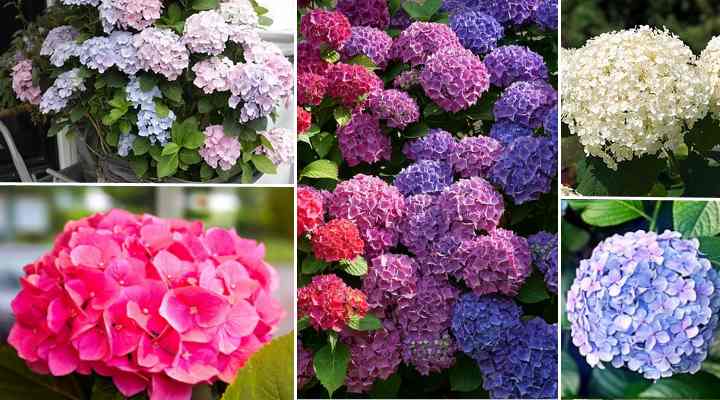
If the hydrangea shrub isn’t flourishing well, it’s advised to move it in the fall before the first frost. Maybe the bushes have grown too close together and are receiving too much sunlight during the day. It’s also possible to move a hydrangea from a pot to the ground.
When to transplant hydrangeas
Transplanting hydrangeas in the fall, when the plant is dormant, is the best time. Without any leaves, the bush should be practically barren. Before the first frost, move the plant to a new location to ensure success. You can transplant a hydrangea any time between December and February in areas with mild winters.
How to transplant hydrangeas
Digging a hole in the new location is the first step in transplanting a hydrangea. Next, free the plant’s root ball from the soil by digging around it. You may need assistance if you have an deep root system in hydrangeas. Remove the hydrangea root ball from its current position gently.
Fill the dirt around the hydrangea shrub, which you just dug, in the fresh hole. Water the root base well. You don’t have to water a hydrangea until the spring after you transplant it in the fall. During the first growing season after being planted, a hydrangea transplant needs frequent watering.
How to Grow Hydrangeas from Cuttings

Take fresh growth cuttings from a healthy plant in early summer to easily propagate hydrangea. Cuttings should be at least 6 inches (15 cm) long, with no blossoms. Make sure there are 2-3 leaves on the cutting by snipping off the cutting just below a leaf node.
Cover the cuttings with a plastic bag and put them in a potting soil-filled pot. Place it in a shaded spot that is not exposed to direct sunlight. Moisture is important for soil health. The cutting should have roots after approximately four weeks, and new stem growth should begin to emerge.
After that, you can move outdoors to a bigger pot. To protect them from frost in late fall, lightly blanket with mulch. You may transfer the new hydrangea plant from its pot to a suitable site in your garden in early spring, after the danger of frost has passed. Instead, in the spring, take stem cuttings and root them in pots for four weeks before planting them directly in your garden.
Hydrangea Flower
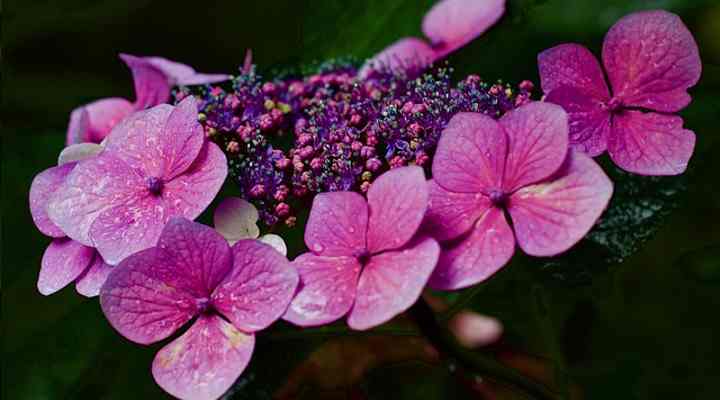
Hydrangea shrubs are known for their spectacular floral display of huge ball-like blooms. Blue, pink, red, lilac, purple, chartreuse, white, and lime-green are some of the hues available in hydrangea blossoms. Similarly, depending on the soil acidity, flowers on bigleaf and mountain hydrangeas change color.
Showy rounded globular flower clusters and delicate flowers like small buds in the center and large 4- or 5-petaled flowers in a ring around the cluster of buds (lacecap hydrangea) are two types of flowers found in hydrangea flower heads. Late spring through the summer, and into the fall, most hydrangea cultivars bloom. Hydrangeas come in six different colors, each with four distinct flower types.
- Mophead hydrangea flowers—Bigleaf hydrangeas have large pom-pom flowers that are usually pink, blue, or white in color.
- Lacecap flowers—A cluster of flower buds in the middle is surrounded by beautiful blooms, giving the flower heads a delicate, lacy look. White blooms bloom on climbing hydrangeas, some bigleaf hydrangeas, and mountain hydrangeas.
- Panicle flowers—On panicle hydrangea and oakleaf hydrangea plants, cone-like hydrangea blooms appear. White, pink, or a mix of both are possible flower hues.
- Snowball hydrangea flowers—Snowball hydrangeas are big globular clusters of white florets, as the name suggests. Smooth hydrangeas are known to have snowball flowers.
How to Change the Color of Hydrangea Flowers
By altering the soil pH, you may change the color of hydrangea blooms. Blue flowers bloom in acidic soil, while pink blooms bloom in alkaline soil in bigleaf hydrangeas such as the mophead and lacecap types. To encourage bigleaf hydrangeas to bloom blue flowers, add organic compost (acetic).
To lower the soil’s pH level, you can also add coffee grinds, crushed eggshells, and citrus peels. Amend the soil with lime to increase the pH level and transform mophead and lacecap hydrangeas pink.
Hydrangea Fertilizer
An all-purpose, slow-release formula with an NPK rating of 10-10-10 is the best type of fertilizer for hydrangeas. In order to boost the health of hydrangea bushes, you may also apply an organic fertilizer made up of sulfur, compost, and peat moss. You may also get a fertilizer specifically made for hydrangea plants.
When and how to fertilize hydrangeas
If you’re using a slow-release fertilizer, the best time to fertilize hydrangea bushes is in the spring. During the growing season, this kind of fertilizer provides enough nutrients to the roots.
Apply fertilizer in March, May, and July if you’re using organic matter. It’s critical to apply fertilizer around the shrub’s drip line when applying it. This prevents root burn and ensures that the hydrangea plant’s roots get an even supply of nutrients.
Pruning Care for Hydrangeas
Pruning is necessary for hydrangeas’ overall care because it encourages robust, bushy development and abundant blooming. Knowing the kind of hydrangea you have is important when deciding when to trim hydrangea plants. Flower buds develop on new wood, while aging wood serves as support for hydrangeas.
When to Prune a Hydrangea

Hydrangeas that bloom on old wood should be pruned in late summer, depending on the type of hydrangea. The following are the ones to look out for:
- Bigleaf hydrangeas (Hydrangea macrophylla)
- Mountain hydrangeas (Hydrangea serrata)
- Oakleaf hydrangeas (Hydrangea quercifolia)
- Climbing hydrangeas (Hydrangea petiolaris)
Late winter to early spring is the best time to trim Hydrangeas that bloom on new wood. The following are the ones listed above:
- Panicle hydrangeas (Hydrangea paniculata)
- Smooth hydrangeas (Hydrangea arborescens)
How to prune hydrangeas
After the hydrangea shrub blooms, begin cutting back the branches to prevent it from blooming on old wood. To keep the shrub’s shape and remove dead branches, simply trim the stems lightly. In addition, in the spring, you can trim branch tips to encourage more tiny flowers rather than large flower heads. In late winter or early spring, cut hydrangeas blooming on new wood back by one-third to reduce their size. To encourage new growth, trim the stems just above the leaf node.
Hard pruning on a smooth hydrangea will result in large flower heads. The hydrangeas may even be cut back to the soil. Minimal pruning, on the other hand, will result in multiple smaller flower heads.
Hydrangea Not Blooming – How to Get Hydrangea to Rebloom

To avoid the bush from dying back to the ground in winter, protect it from frost by blooming bigleaf hydrangea on ancient wood. On old wood, bigleaf hydrangeas bloom. This shows that the showy mophead blooms will only bloom in the spring if the growth from the previous year survives winter. If you trimmed back too much of the previous, woodier growth, bigleaf hydrangeas may fail to bloom.
Protecting hydrangeas from frost during the winter is one way to ensure that they bloom every year. Bigleaf hydrangeas, oakleaf hydrangeas, and mountain hydrangeas should be pruned in late summer as well. In a single season, hydrangeas do not rebloom.
Unfortunately, reblooming isn’t encouraged by deadheading hydrangeas flowers. Hydrangeas, on the other hand, bloom for a long period of time and shouldn’t be a cause for concern when it comes to reblooming.
Pests and Diseases that Affect Hydrangea
Hydrangeas are susceptible to the same pests and foliage diseases as other deciduous perennials. The best way to make sure that strong hydrangeas are resistant to insect and common garden pests is to take care of them properly. On common hydrangea growth problems, here’s some useful information.
Pest affecting hydrangea growth
Here’s how to get rid of hydrangea-insects without using chemicals:
Aphids Cause garden shrubs’ leaves to curl by sucking sap from them. Honeydew, a sticky material, and a black, soot-like substance may also be seen on the leaves. Blast the aphids away with a strong stream of water from your garden hose. Leaf undersides are worth staring at.
Slugs and beetles (rose chafers) eat their way through greenery and flowers. Removing the beetles manually or placing down slug traps are the finest methods to get rid of these pests naturally.
Diseases affecting hydrangea growth

Powdery mildew or leaf spots on hydrangea bushes may be caused by overwatering and insufficient air circulation.
Powdery mildew On hydrangea leaves, this forms a white, powdery substance. A lack of air circulation or too much moisture on the leaves, particularly after watering incorrectly, are the two causes of this fungal infection. Learn how to use milk, baking soda, or neem oil to cure powdery mildew by reading this article on how to combat the fungus.
Leaf spot Brown or black blotches on foliage may be a symptom of watering that is too frequent or not enough air circulation. watering hydrangea plants in the morning and spacing hydrangea bushes correctly are the best ways to avoid this difficulty. Remember that hydrangeas grow best in moist, but never soggy, soil. Roots can rot if the soil is excessively wet, affecting hydrangea development.
Hydrangea Toxicity
Dogs, cats, and other animals are susceptible to Hydrangea toxicity. Plants from the Hydrangeaceae family, according to the ASPCA, include cyanogenic glycoside, which causes vomiting, diarrhea, and depression in animals if they eat the leaves.
Varieties of Hydrangea Bushes (With Pictures)
Because of their colorful flower heads, Hydrangea shrubs are one of the most commonly planted landscaping plants. Some of the hydrangea cultivars from various species are shown below:
Nikko Blue Hydrangea (Hydrangea macrophylla ‘Nikko Blue’)—A mophead type with large 5-inch (12-cm) flower heads is the most popular hydrangea shrub. The flowers are pink rather than blue in alkaline soils. It grows to be 4-6 feet (1.2-1.8 meters) tall and broad.

Lacecap Hydrangea (Hydrangea macrophylla normalis)—The lacecap hydrangea has flower heads that are partly flatten. The purple and pink blooms contrast with the large, lush green leaves. This hugeleaf hydrangea grows to be 3 to 5 feet (1.5 meters) tall and broad.

Pee Gee Hydrangea (Hydrangea paniculata ‘Grandiflora’)—White conical blooms adorn the ‘Pee Gee,’ a variety of tree hydrangea. The giant shrubby hydrangea may reach a height of 10 to 20 feet (3 to 6 meters) and a width of up to 15 feet (4.5 meters).

Pink Hydrangea ‘Pinky Winky’ (Hydrangea paniculata ‘Pinky Winky’)—The cone-shaped pink blooms of this panicle hydrangea are on stiff stems. It has a height of 6 to 8 feet (1.2 to 1.8 meters) and a width of 6 feet (1.2 meters).

Annabelle Hydrangea (Hydrangea arborescens ‘Annabelle’)—This smooth hydrangea shrub has 12″ (30 cm) wide snowball hydrangea blooms. The 3 to 5 ft. (1.5 to 1.5 m) high and 4 to 6 ft. (1.2 to 1.8 m) broad shrub is beautifully rounded in appearance.
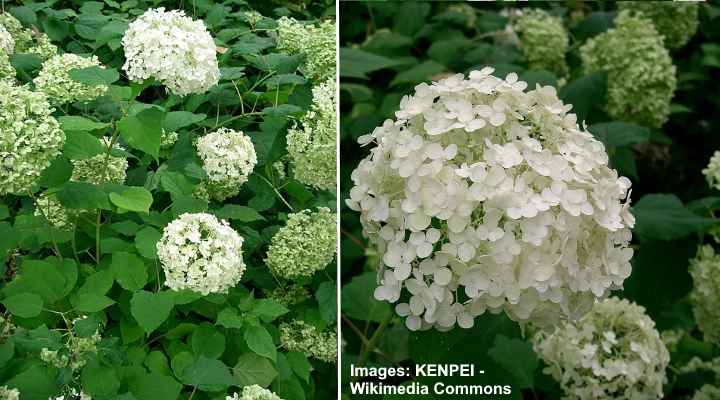
Landscaping with Hydrangeas
In a garden landscape, hydrangeas have several purposes. Flowering shrub borders and screens, as well as foundation plantings and flowering shrub borders, may be grown. Certain cultivars can be grown as hydrangea trees as well. In your front or back yard, consider these hydrangea planting ideas:

Informal borders, hedges, and foundation plants for front of house are all examples of Hydrangea shrubs in landscaped gardens.
- The gorgeous romantic hedge is formed by the white cone-shaped hydrangea blooms on Hydrangea paniculata ‘Limelight.’
- To add splashes of pastel colors to a bushy shrub border, plant blue or pink bigleaf hydrangeas (Hydrangea macrophylla).
- As colorful foundation plants for the front of the home, grow dwarf hydrangea bushes such as bigleaf hydrangea ‘Masja’ (Hydrangea macrophylla ‘Masja’).
- When placed along driveways, walkways, or mixed flower beds, small hydrangea bushes with pink, blue, or white mophead flowers are stunning.
- Dwarf hydrangeas in huge pots create amazing blooms throughout the summer and fall in a container garden or on a patio.
- Plant the Pee Gee Hydrangea (Hydrangea paniculata ‘Grandiflora’) and prune suckers to encourage a central stem to develop, then watch it flourish into a magnificent hydrangea tree with huge white cone-like flowers.
